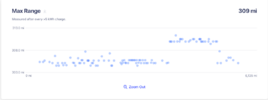Utumno
2 x Model Y LR (2022 Q2 & 2023 Q3)
James, quick question I hope.
Does Tessie hold any information about AC charger power fluctuations, other than the obvious charge amperage ?
I have recently moved house, have had a new charger fitted, and have a relatively complex setup of tariff, external charge control through my electricity supplier.
My charger is regularly reporting that the Tesla isn't charging as quickly as expected, and in those periods looking at the Tesla app (and Tessie) I can indeed see the amperage being drawn by the vehicle drop from 32A, sometimes to as low as 4A but most often to 24A, 16A or 10A. The installation should be rated at 32A.
Really what I'm trying to find is logs to cross-correlate whether the Tesla is making the decision to reduce the amperage draw, or whether the Tesla is having a lower amperage supplied by the charger (or both, if both situations are happening). I've no known way of getting this out of the Tesla app, so wondered whether these low level logs are available to Tessie in some way for these kind of troubleshooting expeditions ?
Does Tessie hold any information about AC charger power fluctuations, other than the obvious charge amperage ?
I have recently moved house, have had a new charger fitted, and have a relatively complex setup of tariff, external charge control through my electricity supplier.
My charger is regularly reporting that the Tesla isn't charging as quickly as expected, and in those periods looking at the Tesla app (and Tessie) I can indeed see the amperage being drawn by the vehicle drop from 32A, sometimes to as low as 4A but most often to 24A, 16A or 10A. The installation should be rated at 32A.
Really what I'm trying to find is logs to cross-correlate whether the Tesla is making the decision to reduce the amperage draw, or whether the Tesla is having a lower amperage supplied by the charger (or both, if both situations are happening). I've no known way of getting this out of the Tesla app, so wondered whether these low level logs are available to Tessie in some way for these kind of troubleshooting expeditions ?



